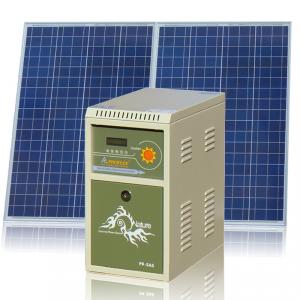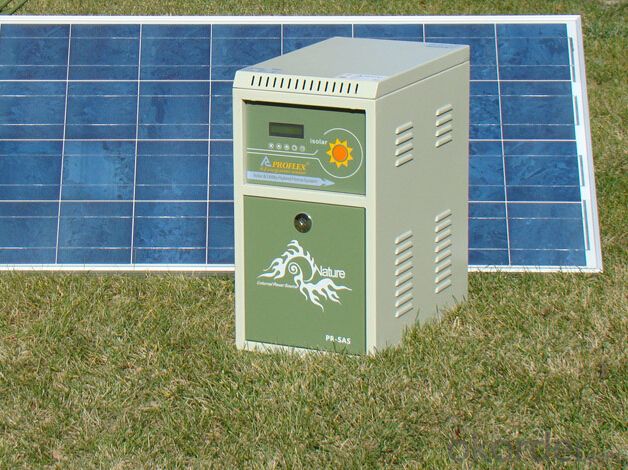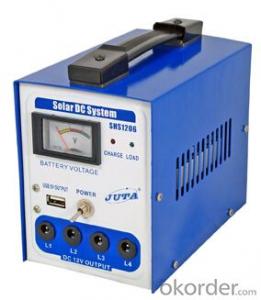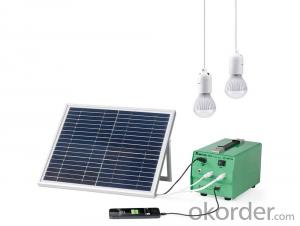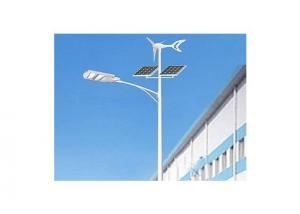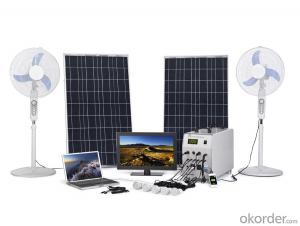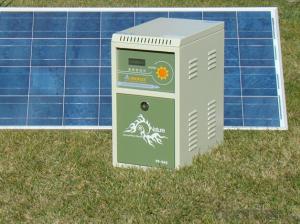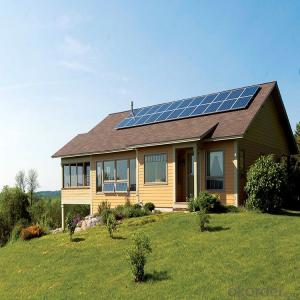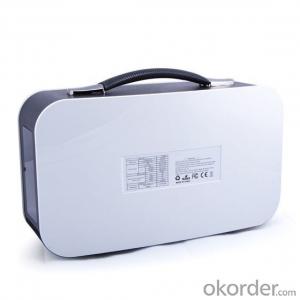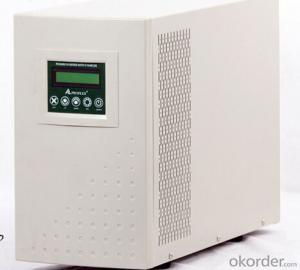Solar Energy Systems Brooklyn - Solar AC Power System with Maximum 150Wp 300W Output
- Loading Port:
- Tianjin
- Payment Terms:
- TT OR LC
- Min Order Qty:
- 10 set
- Supply Capability:
- 10000 set/month
OKorder Service Pledge
OKorder Financial Service
You Might Also Like
Specification
Daily use reference
TV 70W x 4 hours
Lighting 30W x 6 hours
Fan 50W x 6 hours
Laptop 60W x 2 hours
Total loading power: 210W
Total power consumption per day: 880Wh (0.88kWh/day)
AC solar power system consists of solar batteries, solar controller, battery, inverter components.
Used to solve rural or remote areas without electricity, such as highland, island, pastoral, villas, border posts and other military and civilian life electricity.
Model No. | PR-SAS300 |
Polycrystalline solar panel | 2pcs 75Wp parallel |
Max. solar panel charging voltage | 17.6V |
Max. solar panel charging current | 8.54A |
Inverter output | Pure sine wave 300W |
Inverter peak start | 900W (3s) |
Inverter output voltage/frequency | 220V/50Hz |
Inverter AC charger | 12V/10A |
Solar charge controller | 12V/15A |
Cabinet material | Steel box of zinc-plated and lacquer-coated |
Battery type | Deep cycle maintenance free |
Battery capacity | 1 x 12V 100Ah |
Operating temperature | -20oC-55oC |
Packing for solar panel | 0.06cbm/20kg |
Packing for integrated solar charge control inverter cabinet | 0.11cbm/15kg |
Packing for battery | 0.02cbm/31kg |
Whole system per set | 0.19cbm/66kg |
Optional monitoring software | CD-ROM for computer and SNMP card for internet |
FAQ
1. How do I decide which system is right for me ?
For protection from long outages, include a generator or solar panels in your Must solar system. Shorter outages can be handled by a battery-only system.
2. Where my system will be installed ?
Must solar systems are usually wall-mounted near a home's main electrical (circuit breaker) panel.
3. How do I install my system ?
A solar backup inverter is connected to a home electric system , we will supply detailed installation manual and videos for our customers .
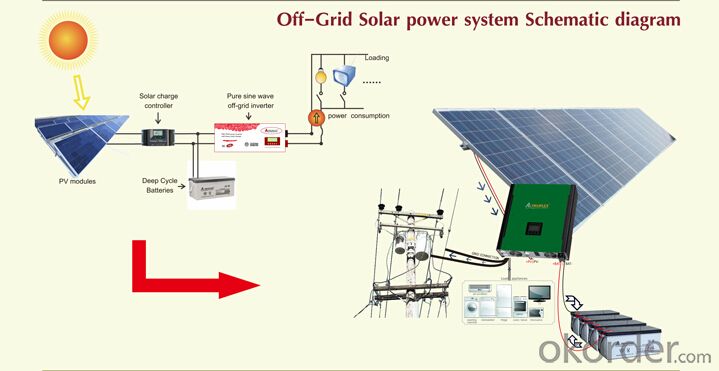
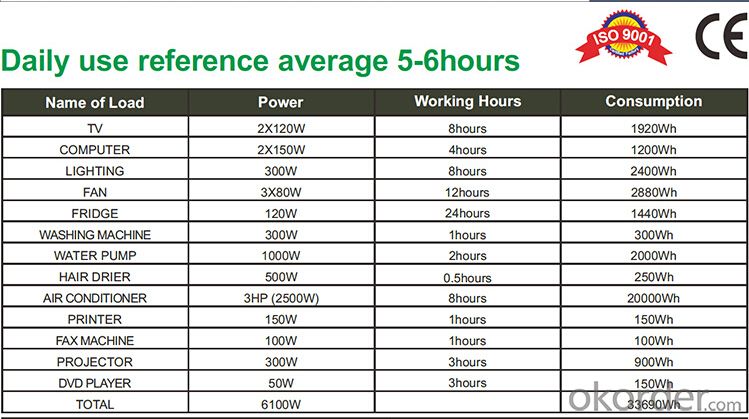

- Q: Do solar energy systems require surge protection?
- Yes, solar energy systems do require surge protection. Surge protection is necessary because solar energy systems are vulnerable to power surges caused by lightning strikes, grid fluctuations, or other electrical disturbances. Power surges can damage or destroy the delicate electronic components of a solar energy system, such as inverters or charge controllers. Surge protection devices, such as surge protectors or surge arresters, help to divert excess voltage away from the system, preventing damage and ensuring its longevity. Additionally, surge protection is often required by electrical codes and regulations to ensure the safety and reliability of solar energy systems.
- Q: How does the age of a solar energy system affect its performance?
- The performance of a solar energy system can be significantly influenced by its age. As time goes on, solar panels may experience a decline in efficiency caused by various factors. A primary factor is the deterioration of the photovoltaic cells themselves, which can occur due to exposure to sunlight, extreme temperatures, and other environmental factors. Consequently, this degradation can lead to a decrease in the overall power output of the system. Moreover, the components of the solar system, such as inverters and wiring, may also be subject to wear and tear over time. Inverters have the responsibility of converting the direct current (DC) produced by the solar panels into usable alternating current (AC) electricity. With age, inverters may become less efficient or even fail, thereby impacting the system's performance. Another aspect impacted by the age of a solar energy system is the technology itself. Solar technology is constantly advancing, and newer systems tend to be more efficient and capable of producing higher power outputs compared to older systems. Consequently, older solar energy systems may not be able to match the performance of newer, more advanced systems. To address performance issues related to the age of a solar energy system, regular maintenance and inspections are crucial. Activities such as cleaning the panels to remove dirt and debris, checking for loose connections, and ensuring proper alignment can all contribute to maintaining optimal performance. In conclusion, the performance of a solar energy system can be influenced by factors such as the degradation of photovoltaic cells, wear and tear on components like inverters, and advancements in solar technology. By undertaking regular maintenance and staying updated with the latest advancements, it is possible to prolong the lifespan and optimize the performance of a solar energy system.
- Q: How do solar energy systems affect the insurance premiums of a property?
- Solar energy systems can potentially affect insurance premiums of a property in a positive way. Installing solar panels can increase the value of a property, which may result in higher replacement cost coverage and thus slightly higher premiums. However, many insurance companies offer discounts or specialized policies for homes with solar energy systems, as they are considered less risky due to reduced reliance on traditional power sources and potential for energy savings. Ultimately, the impact on insurance premiums will vary depending on several factors, including the location, size, and efficiency of the solar energy system.
- Q: Can a solar energy system be used in areas with high levels of air pollution?
- Yes, a solar energy system can still be used in areas with high levels of air pollution. While air pollution may affect the efficiency of the solar panels to some extent, they can still generate electricity. However, it is important to regularly clean and maintain the panels to ensure optimal performance. Additionally, investing in advanced air filtration systems can help mitigate the impact of air pollution on the solar energy system.
- Q: Can solar energy systems be used in all climates?
- Solar energy systems can be used in all climates to some extent, but their efficiency and effectiveness may vary. While solar panels can generate electricity even in colder climates, they may produce less energy compared to sunnier regions. Additionally, extreme weather conditions like heavy snowfall or frequent cloud cover can temporarily reduce solar energy production. However, advancements in solar technology, such as the use of dual-axis tracking systems, can help optimize energy generation in different climates.
- Q: What is the role of voltage optimizers in a solar energy system?
- The role of voltage optimizers in a solar energy system is to optimize and regulate the voltage levels of the electricity produced by the solar panels. Solar panels generate direct current (DC) electricity, which needs to be converted to alternating current (AC) in order to be used by most household appliances and to be fed into the electrical grid. However, the voltage produced by solar panels can vary depending on various factors such as sunlight intensity, temperature, and shading. This inconsistency in voltage can lead to inefficient energy production and can potentially damage the electrical equipment connected to the system. Voltage optimizers help address these issues by stabilizing and regulating the voltage levels within the solar energy system. They ensure that the voltage produced by the solar panels is consistent and within the optimal range for efficient energy production. By maintaining a stable voltage, voltage optimizers also protect the electrical equipment from potential damage caused by voltage fluctuations. Furthermore, voltage optimizers can improve the overall performance and efficiency of the solar energy system. By optimizing the voltage levels, they reduce energy losses and maximize the electricity output of the solar panels. This improves the overall system efficiency and helps to maximize the return on investment for the solar energy system. In summary, voltage optimizers play a crucial role in a solar energy system by stabilizing and regulating the voltage levels, ensuring efficient energy production, protecting electrical equipment, and maximizing the system's overall performance and efficiency.
- Q: Can solar energy systems be used in areas with frequent hurricanes?
- Solar energy systems are indeed viable in areas prone to hurricanes. Despite the potential damage hurricanes can inflict on these systems, there are strategies to mitigate the associated risks. To begin with, it is possible to design and install solar energy systems in hurricane-prone regions in a manner that can withstand strong winds. This involves employing sturdier mounting systems, reinforced frames, and secure anchoring techniques. Additionally, optimizing the orientation and tilt angle of the solar panels can minimize wind resistance. Furthermore, regular maintenance and inspections are crucial for identifying any potential issues or damages before a hurricane strikes. This proactive approach allows for timely repairs or replacements, ensuring the system remains operational and secure during severe weather events. In the event of a hurricane, it is important to have emergency protocols in place to safeguard the solar panels and other components. Temporary removal of the panels and indoor storage or utilization of protective covers to shield them from debris are some viable options. Moreover, the use of microinverters or power optimizers can enhance the resilience of solar energy systems in hurricane-prone areas. These advanced technologies enable each solar panel to function independently, minimizing the impact of damage to a single panel and preventing the entire system from shutting down. Lastly, solar energy systems can contribute to the resilience of communities during and after hurricanes. By incorporating proper battery storage, these systems can provide backup power during power outages, ensuring the continuity of essential services and meeting critical electricity needs like lighting, refrigeration, and medical equipment. In conclusion, although precautions must be taken to ensure the durability and functionality of solar energy systems in hurricane-prone areas, they can effectively harness clean and renewable energy even in the face of frequent hurricanes.
- Q: Can solar energy systems be used in powering veterinary clinics or animal shelters?
- Yes, solar energy systems can definitely be used to power veterinary clinics or animal shelters. Solar energy systems, such as solar panels, harness the power of sunlight and convert it into electricity. This electricity can be used to power various electrical appliances and devices, including those found in veterinary clinics and animal shelters. By installing solar panels on the roof or in an open area near the veterinary clinic or animal shelter, these establishments can reduce their dependence on traditional electricity sources and utilize clean and renewable solar energy. Solar power can be used to run equipment such as lights, heating and cooling systems, medical equipment, refrigerators for vaccines and medications, computers, and other essential devices. Furthermore, using solar energy systems can help these establishments save on electricity costs in the long run. Veterinary clinics and animal shelters often consume a significant amount of electricity due to the nature of their operations, such as maintaining proper temperature and lighting conditions, running medical equipment, and maintaining a comfortable environment for animals and staff. By utilizing solar power, these establishments can significantly reduce their electricity bills, allowing them to allocate more resources towards animal care and welfare. Additionally, using solar energy systems in veterinary clinics and animal shelters aligns with their commitment to environmental sustainability. By reducing reliance on fossil fuels and utilizing clean and renewable solar energy, these establishments can contribute to reducing carbon emissions and minimizing their ecological footprint. In summary, solar energy systems can be used effectively in powering veterinary clinics and animal shelters. They provide a reliable and sustainable source of electricity, reduce operating costs, and demonstrate a commitment to environmental responsibility.
- Q: Can solar energy systems be used for powering remote monitoring equipment?
- Solar energy systems have the capability to power remote monitoring equipment. By utilizing photovoltaic (PV) panels, solar energy systems can convert sunlight into electricity, enabling the operation of various devices and equipment. Solar energy systems are well-suited for powering remote monitoring equipment, such as weather stations, surveillance cameras, or communication systems. These systems are particularly advantageous in isolated or off-grid areas where access to electricity may be scarce or nonexistent. Solar energy, being sustainable and renewable, is an excellent alternative to fossil fuels and traditional electrical grids for providing power to remote monitoring equipment. Moreover, solar energy systems can be combined with battery storage to ensure a continuous power supply, even during periods of limited sunlight.
- Q: How long does it take to install a solar energy system?
- The time it takes to install a solar energy system can vary depending on various factors such as the size and complexity of the system, the availability of equipment and materials, and the experience of the installation team. Generally, a residential solar energy system installation can take anywhere from a few days to a few weeks, while larger commercial installations may take several weeks or even months. It is recommended to consult with a professional solar installer to get a more accurate estimate based on your specific requirements.
Send your message to us
Solar Energy Systems Brooklyn - Solar AC Power System with Maximum 150Wp 300W Output
- Loading Port:
- Tianjin
- Payment Terms:
- TT OR LC
- Min Order Qty:
- 10 set
- Supply Capability:
- 10000 set/month
OKorder Service Pledge
OKorder Financial Service
Similar products
Hot products
Hot Searches
Related keywords
